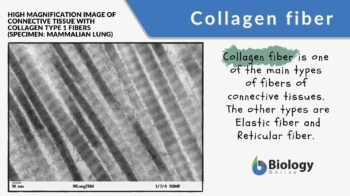
Collagen fiber
n., plural: collagen fibers
[ˈkɒlədʒən ˈfaɪ.bɚ]
Definition: fiber in the extracellular matrix of connective tissue
Definition of collagen fiber
Collagen fiber is the fiber in the extracellular matrix of connective tissues characterized by being elongated and made up of collagen glycoproteins. It is typically arranged in branching bundles of indefinite length. It is a strong insoluble fiber. It occurs in the skin, tendon, ligaments, bone, and cartilage.
Supplement
The connective tissue is one of the major types of tissues in higher animals, including humans. One of the features of connective tissues is the presence of fibers. There are three major types of fibers associated with connective tissues: (1) collagen fibers, (2) elastic fibers, and reticular fibers.
Collagen fiber is the most predominant type of connective tissue fiber. It is characteristically white and composed of collagen.
Collagen is a biomolecule produced by fibroblasts and forms the collagen fiber. The collagen, in turn, is an aggregate of tropocollagens. The tropocollagen is made up of three polypeptide strands (referred to as alpha peptides) that are twisted together into a superhelix or a right-handed triple helix. The amino acids in each chain are arranged in a regular pattern. The typical pattern is Gly-Pro-X or Gly-X-Hyp (the X being any other amino acid residue). There are various types of collagen (e.g. type I, type II, type III….). More than twenty collagen types have been described. In the human body, the most predominant type, though, is type I collagen. It occurs in skin, tendon, bone, vasculature, and organs.
Variant: collagen fibre (British). Synonym: white fiber. See also: collagen, connective tissue, elastic fiber, reticular fiber.
Try to answer the quiz below to check what you have learned so far about collagen fiber.


